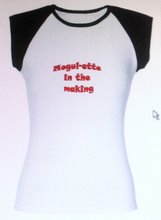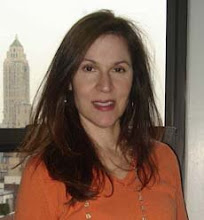Inspiration for a business can come from very unusual places. For Laura Allen (that's her below on the right) , co-founder of "The 15secondpitch", it came from a friend looking to meet date-worthy women. She turned her knack for connecting people into a profession. How'd she do it? Read on!
During the dot-com boom Laura worked at Cheetahmail.com, which somehow managed to survive the bust and was acquired by Experian in 2004. She'd been the first hire there so she was given a lot of freedom at the company, but eventually she got bored with the corporate structure and the rules, so in 2000 she left. Just as Laura was figuring out what to do next with her life, 9/11 happened. The internet industry was devastated, leaving behind a trail of laid-off techies. Looking for ideas on what to do next, Laura and her partner, Jim, who is a database programmer, attended a networking event in Los Angeles. It was there that they met their friend David, a good looking, single, MBA grad and fellow job seeker, who asked Laura to give him a hand meeting cute, single women at the conference. He found he got a much better response when Laura introduced him, and Laura had a ball "pitching" him to the ladies.
structure and the rules, so in 2000 she left. Just as Laura was figuring out what to do next with her life, 9/11 happened. The internet industry was devastated, leaving behind a trail of laid-off techies. Looking for ideas on what to do next, Laura and her partner, Jim, who is a database programmer, attended a networking event in Los Angeles. It was there that they met their friend David, a good looking, single, MBA grad and fellow job seeker, who asked Laura to give him a hand meeting cute, single women at the conference. He found he got a much better response when Laura introduced him, and Laura had a ball "pitching" him to the ladies.
Jim, on the other hand, was not having much luck at networking and was thinking there had to be a better way to make connections, and when the two exchanged stories, they stumbled upon the idea for a 15-second pitch.
When they got back home they immediately checked the domain name, and finding it still available, they registered it that night.
Another problem with networking events is that you end up with a bunch of business cards, and afterwards you can't remember who most of those people are. So, they thought, why not create a card that contains a pitch which explains what their company is about? They went to work to turn the idea into a business, and spent the first two years building a website where people could create 15secondpitch cards.
Then in 2003 they decided Laura would teach a workshop on how to create a 15secondpitch. A friend in New York let her use her conference room, and she advertised her 2-hour course on a forum she found in Fast Company called "Company of Friends", that reached a few thousand people just in NY and NJ.
The event was free and about 15-20 people showed up. They each told their story and one guy shared that he'd been trying to get in touch with a VP of Coca-Cola for the past two years. Then another guy said his uncle worked there, and that he'd connect him. That's when Laura saw the power of what she calls the "third party pitch."
Heather is another of Laura's "third party pitch" success stories. She was a reporter who had perfected her "I'm a journalist" pitch, but there was only one problem - she no longer wanted to be a reporter. Her dream was to become a wedding planner. Laura advised her to keep her day job and start moonlighting on the side. They created a wedding planner pitch that same day, which she later shared with her husband. He in turn started telling his colleagues about her, and one of them had just gotten engaged, so he asked Heather to plan his wedding. Three weeks after creating the 15-second pitch Heather landed her first job through a "third party pitch"!
The other thing that worked for Heather was creating an image when describing her services. She went from saying "I'm a reporter but I want to be a wedding planner", to "I have an eye for detail so I'm starting a wedding planning business." Painting a picture in people's minds helps them understand what you do, especially with tech jobs - it's easier for people to buy into an idea if you make your pitch descriptive, giving examples, telling stories, making it rich with details.
Anyway, back to the workshops. In 2005 Laura decided to start charging for her seminars, but she needed money for marketing, so she went back into the corporate world, saving the money coming in from her day job and from teaching the seminars at night. After about a year she got laid off, with 2 weeks severance pay, plus unemployment benefits. Laura was thrilled. With the money she had put away she started marketing her monthly workshop, and shifted her business model more towards corporate clients like Merrill Lynch and non-profits like Cine Women.
The website has now gone through three major revisions, and they added a pitch wizard a year ago to automate the process of printing the pitch cards. Laura just re-launched her blog last week to focus on how to put together a killer 15secondpitch, and how to use it after you create it. In January they'll be unveiling their latest product (you heard it here first!), an e-learning platform that allows people to sign up for classes and follow at their own pace. Users will be able to create a 15secondpitch plus other related content using a tool that's partly automated and partly customized by Laura.
The 15secondpitch is used by lawyers, VC's , real estate brokers, freelancers - it's especially good for freelancers because their existence hinges on how well they can pitch, and they need to be constantly pitching new business. Marketing consultants, career coaches, college grads, financial planners - they can all benefit from it.
Here are 4 things Laura says an effective 15secondpitch should include:
- Who you are - Tell then your name AND the name of your company!
- What you do - avoid the "kitchen sink" pitch - don't tell your entire career history - focus on one thing and be specific. She's suggests preparing a separate pitch for everything you do.
- Why you're the best at what you do.
- A call to action - the crown jewel.













No comments:
Post a Comment